Lea Wait's Blog, page 18
March 16, 2025
Who Doesn’t Love a Good Con?
Rob Kelley here, thinking about scams and cons in fiction and real life. So I’ll start by saying a nonprofit I volunteer for was the target of a scam this last week. I’ll come back to that in a sec.
Con artists and cheaters, flim flammers and fakers, scammers and swindlers. No clearer sign of the popularity of trickery in our lives than the huge number of words to describe shams and skullduggery (OK, I’ll stop!). Our earliest stories include trickery: Odysseus, Loki, Raven, and, of course, the serpent in the garden. Something about lying is at the core of our relationships with language and with each other. And, also true, many of us lie for fun and profit–it is, after all, an alternate definition for fiction.
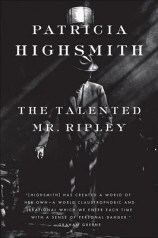 Maybe that’s why we love a good con. Who doesn’t come to admire Thomas Ripley even though he’s a pathological liar? We find ourselves actually rooting for him as the protagonist, worried he’ll get caught, relieved each time he gets to continue his murderous, stolen life as Dickie Greenleaf.
Maybe that’s why we love a good con. Who doesn’t come to admire Thomas Ripley even though he’s a pathological liar? We find ourselves actually rooting for him as the protagonist, worried he’ll get caught, relieved each time he gets to continue his murderous, stolen life as Dickie Greenleaf.
 And we root for poor, sad sack Nick Dunne, with his disappointing life and inexplicably missing wife. But after we meet Amy halfway through the book, we are surprised and disrupted, unhappy with her deception, then a little more forgiving when we understand Nick’s casual betrayal, then supportive in her desire for revenge, then maybe somewhere in the middle in her final power play.
And we root for poor, sad sack Nick Dunne, with his disappointing life and inexplicably missing wife. But after we meet Amy halfway through the book, we are surprised and disrupted, unhappy with her deception, then a little more forgiving when we understand Nick’s casual betrayal, then supportive in her desire for revenge, then maybe somewhere in the middle in her final power play.
But the point is, we love cons because we love the ride.
Two weeks ago a small nonprofit I work with was contacted by a potential donor getting our mailing address details for a substantial donation. We provided that and asked where they had heard about our work, which they never answered. Instead, when the check was mailed–USPS with tracking–the donor asked for a deposit receipt. That was a new one for us, since most donors only ask for an acknowledgement. But it was a decent sized check, so we figured whatever made the donor comfortable.
Unfortunately our administrator was out on vacation that week, so it took a few days to get a staff member to the mail to pick up the check. The donor was very anxious, frustrated that we hadn’t deposited it.
My Spidey sense was tingling by this point. The organization the check was from had an unusual name, but we figured it might be a family business. The bank it was drawn on was real, an internet bank in the South. The check was for just shy of double the originally committed donation figure, but we figured they just committed more funds, so our bookkeeper deposited the check, and we sent along the deposit receipt and acknowledgement.
I joked with our bookkeeper that this felt like some kind of Nigerian Prince Scam. She wasn’t sure, and, frankly neither was I. Until, that is, the next email arrived.
Oh, goodness, our donor said, our secretary wrote the check for too much and we are traveling and need that money to pay a vendor. Can you please wire the excess funds back to us, or transfer it via PayPal?
Two seconds of searching revealed the con: The Overpayment Scam. (I confess I was disappointed this scam didn’t have a cool name like Spanish Prisoner, Pig in a Poke, Melon Drop, Badger Game, Pigeon Drop, Spear phishing, or my favorite: Pig Butchering. Again, so much language play!)
According to the Federal Trade Commission, a scammer will “‘accidentally’ send a check for too much, and ask you to refund the balance. But that’s a scam . . . These scams work because fake checks generally look just like real checks, even to bank employees. They are often printed with the names and addresses of legitimate financial institutions.” And “it can take weeks for a bank to figure out that the check is a fake.” In the meantime you’ve refunded the overpayment and you’re out that money when the scammer has moved on.
 I made myself a pledge. I would not lie to this scammer, just keep them engaged as long as I could. I took such glee from this whole game that at one point I was actually rubbing my hands together like a bad Bond villain or Mr. Burns from the Simpsons.
I made myself a pledge. I would not lie to this scammer, just keep them engaged as long as I could. I took such glee from this whole game that at one point I was actually rubbing my hands together like a bad Bond villain or Mr. Burns from the Simpsons.
We’d sent the deposit slip to the scammer last Wednesday, and by Friday the scammer was beside himself. He asked me to send it via Zelle or Venmo (we said we didn’t have that set up on our business account) and that our administrator was out through the end of the week (also true). By Friday we finally got the scammer to give wiring instructions, and by that point we had notified our nonprofit’s bank that the check was probably bogus, and the bank the check was fraudulently drawn on, and the bank the wire was supposed to go to, that they were part of a scam.
The scammer kept emailing asking if the wire was going out, and I said I was talking to the bank (I was, indeed, talking to the bank against which the fake check was written at that very moment). On Monday when no wire had shown up the scammer frantically begged us to wire the money immediately for same day execution, and I had to tell them that the check had not been accepted.
It was probably going a little too far to ask him for a replacement check for the original donation account, but I did it anyway.
I’m hardly the first person who has taken glee from messing with scammers, with Exhibit A being the scam revenge granny from the UK company Virgin Media/O2. This particular AI chatbot is targeted at computer support scams and is programmed to waste as much scammer time as possible.

Click on the image to watch a short video demo, dear.
No surprise, the revelation to our scammer that we were on to the fake check ended our correspondence. And while I had some fun, I am aware that this scammer, like thousands worldwide might, have very well have been part of a “scam farm,” the scope and scale of which have multiplied all over the globe, with trafficked people forced to run online and telephone scams in horrific conditions and against their will.
I guess for me it just brought home the truisms that underlie fiction, and especially crime fiction. We make up stories with violence and mayhem to show our characters, our people, righting wrongs, or at least exposing them. We don’t seek to cheat our readers, but we’re not unhappy to string them along, distract them with a red herring, then surprise them with a quick turn or a surprise reveal that brings justice, or knowledge, or closure.
I mean, who doesn’t love a good con?
March 14, 2025
Weekend Update: March 15-16, 2025
 Next week at Maine Crime Writers there will be posts by Rob Kelley (Monday), Matt Cost (Tuesday), Kaitlyn Dunnett/Kathy Lynn Emerson (Thursday) and Kate Flora (Friday).
Next week at Maine Crime Writers there will be posts by Rob Kelley (Monday), Matt Cost (Tuesday), Kaitlyn Dunnett/Kathy Lynn Emerson (Thursday) and Kate Flora (Friday).
In the news department, here’s what’s happening with some of us who blog regularly at Maine Crime Writers:
Matt Cost is kicking off his COST TALKS for 2025 next week. These talks will focus on the evolution of a book with special emphasis on his recently released Mainely Mayhem and his upcoming publication of The Not So Merry Adventures of Max Creed.
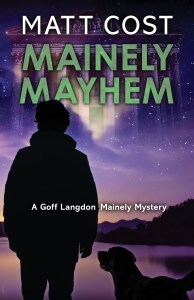
On Thursday, he will be in Lovell, Maine, at the Charlotte Hobbs Memorial Library at 6:00 p.m. Next Saturday, March 22nd, Cost will be at the Merrimac Public Library in Merrimac, Massachusetts at 1:00 p.m. with fellow authors Edith Maxwell and BJ Magnani for a program called: We’re Not Making This Up. What’s the story behind the story? Hear how authors combine personal experiences and events ripped from the headlines to create compelling mysteries. From that first idea, to research and their daily writing schedule, authors discuss their creative process.
Cost is busy filling out his schedule for the year and is actively looking to add venues to his COST TALKS program. If you, your library, book club, or organization would be interested in having him come by for a talk, please contact him at matthew-cost@comcast.net.
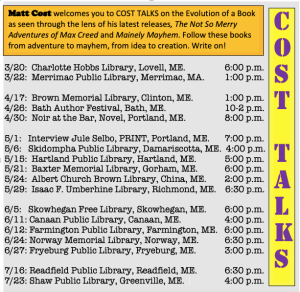
An invitation to readers of this blog: Do you have news relating to Maine, Crime, or Writing? We’d love to hear from you. Just comment below to share.
And a reminder: If your library, school, or organization is looking for a speaker, we are often available to talk about the writing process, research, where we get our ideas, and other mysteries of the business, along with the very popular “Making a Mystery” with audience participation, and “Casting Call: How We Staff Our Mysteries.” We also do programs on Zoom. Contact Kate Flora
Unsolicited Advice
Writing is a solitary thing. We writers spend a lot of time in our heads, talking to ourselves on long walks, wondering exactly how plausible it would be to hide a body in the snowbank of the Hannaford’s parking lot or to shove somebody off one of the cliffs a Two Lights State Park. These conversations are not always easy to have with other people. Or my children. A few years back my younger son, who likes to check books out of the school library for other people in our house, asked for a book about murder. The librarian gave me a call, concerned. I was able to explain things. Mostly.
Perhaps, I decided, my story ideas were not the best topics for dinner conversation.
So I did what any other self-respecting person who doesn’t really know what they’re doing does. A quick google search. A few emails to old friends who were published. An even more desperate series of emails to writers I liked but didn’t know.
And I got some great advice, which I’ll list here, in no particular order.
 1.) Form a community. Join local chapters of organizations like SinC, MWA, or the Maine Writers and Publishers Alliance. Show up for other writers at book events. Attend conferences like Crime Bake, Crime Wave… The list goes on. Put yourself out there. Celebrate others. We are in this together, we lift each other up.
1.) Form a community. Join local chapters of organizations like SinC, MWA, or the Maine Writers and Publishers Alliance. Show up for other writers at book events. Attend conferences like Crime Bake, Crime Wave… The list goes on. Put yourself out there. Celebrate others. We are in this together, we lift each other up.
 2.) Read. Read poetry. Read in your genre. Read what you like. Read a few books that make you uncomfortable. Think about why they make you feel that way. Read more.
2.) Read. Read poetry. Read in your genre. Read what you like. Read a few books that make you uncomfortable. Think about why they make you feel that way. Read more.
3.) Celebrate the wins where you can, when you can. You finished a manuscript? That’s a win. 2 agents requested pages? That’s a win. You sold a short story? Huge win. Shortlisted for an award? Celebrate that stuff!
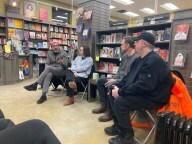 4.) Start your next project. It’s really easy to keep revisiting the project you just finished. But I’ve shelved a thing or two, some of which will probably never see the light of day. And who knows? I might revisit some of them. But a little percolation never hurt the written word.
4.) Start your next project. It’s really easy to keep revisiting the project you just finished. But I’ve shelved a thing or two, some of which will probably never see the light of day. And who knows? I might revisit some of them. But a little percolation never hurt the written word.
5.) It does not hurt to ask. And no doesn’t mean people hate you. Ask those writer friends to join you for a book talk or a Noir at the Bar or an Agatha Christie play. Ask to volunteer. Ask somebody to read your manuscript or a piece of it. They might say no. They might say yes. But you won’t know if you don’t ask.
 6.) Do what works for you but don’t be afraid to try new things. I tend to ruminate over a story for days and by the time I sit to write it, most of it is already teased out. I’ve tried tight outlines and they don’t work well for me. But my friend outlines everything. Her stories are beautiful. Mine are too.
6.) Do what works for you but don’t be afraid to try new things. I tend to ruminate over a story for days and by the time I sit to write it, most of it is already teased out. I’ve tried tight outlines and they don’t work well for me. But my friend outlines everything. Her stories are beautiful. Mine are too.
7.) Local stuff abounds! Your local library is your friend. There are often book talks or writing groups or community events posted. And a librarian that loves you is gold. Get to know your local bookseller. I happen to be good friends with mine. And that bookstore is a happy place for me. Stay tapped into the other local organizations. The Maine Historical Society is a GIFT to Maine writers. Check out THIS upcoming programming. And they have an amazing archive. And they do readings and events in the garden with beer!! Or the local theater is putting on an Agatha Christie play. Or the Telling Room is doing a youth reading. Or Novel, in Portland. A literal haven for anyone who loves reading. Maine has so much to offer to writers by way of community and support.
[image error]8.) And finally, people (like me) will offer up all sorts of advice. Some of it will be great. Some of it will be the worst advice ever. My friend was once in a critique group of somebody who really hated any discussion of weather. Any time weather was included in any piece of writing, he’d underline it and simply say – WEATHER!!! in the margin. For me, I have two or three really trusted people I can turn to. I ask them for either big picture stuff, “What is working in this? What isn’t?” or, if I’m worried about something specific, I’ll ask about that. “The opening here feels forced to me. Thoughts?” Find your people, shower them with appreciation. And if you’re in a group that makes you feel embarrassed or ashamed or like you aren’t good enough? It’s okay to look elsewhere.
I’m wondering – what advice do you offer up – unsolicited – to other writers?
Gabi
March 12, 2025
The Winter of My Discontent

Vaughn C. Hardacker
Vaughn Hardacker here: I have made my dislike of winter well known in several earlier posts. This winter, especially the months of February and March, have been truly rough. Three weeks ago I lost my internet. When I contacted the provider, Trailrunner, I was told the problem was due to a contract dispute with the company that provides the last leg of the network, not a technical issue—some history. In the past, my ISP was Consolidated Communications. They were terrible, so I switched to Trailrunner. With Trailrunner, I experienced a lot of the issues that I had with Consolidated, but their support people were a lot better that those of CCI. When I received an email from the CEO of Trailrunner explaining the problem was a contractual dispute with the provider of the last link of their network. They utilize Consolidated’s tower to provide wireless to the router in the end user’s location. Consolidated turned off their towers, believing that if the outage went on long enough, Trailrunner users would sign on with them. (Consolidated has routinely used this tactic with other companies.) After two and a half weeks, Trailrunner sent out a technician to replace the SIM Card in the router, so I got a temporary link to the internet via AT&T. I won’t go into detail about how high I jumped when I learned that I was still dealing with Consolidated—albeit by proxy.
So, the Internet issue was resolved. On to issue number two (It has been my experience that this kind of crap happens in threes.),. On Friday, February 28, Jane, my partner, brought to my attention that there was no heat in the living room. This has happened in the past. When it did, I went to the basement, opened a valve, and purged the line. We have baseboard heat, and periodically, I had to open a valve and let steam out of the line until water started to run. This time, the valve malfunctioned because it wouldn’t shut off, and boiling water ran out of the boiler and wouldn’t stop. I ended up jury rigging a hose system that took the water to our sump pump. I called a local heating contractor. He showed up on Saturday the first. He looked at the system and turned off the water feed to the boiler. I went upstairs to let him work. An hour later, I went down, and he said, “I got some bad news. You need a new boiler.” I asked for an estimate. He had to work one up, so we spent the weekend in temperatures in the low teens and no heat (It was a toasty 37 in the living room). Have I mentioned that our hot water also comes from the boiler? Well, it does. I took some sheets and blocked off the dining room, Kitchen, one bedroom, and one bathroom. We have a pellet stove that keeps them warm. The estimate came on Monday—$ 12,260 to $14,250. So here we are still living with no heat and imposing on neighbors who let us shower at their house. The neighbor started a gofundme for us, and thus far, we have received about $3,000 in donations. I am trying to arrange for some grants and/or a loan.
Are you ready for #3? This past weekend, we had a storm with thirty-mile-an-hour winds. I got up early on Saturday, and my snowblower wouldn’t start. At this point, I was considering writing a story about committing suicide and doing some real-life research. I looked to the heavens and asked: “What have I done to you, Lord?” He, or she, must have taken pity on me. The snowblower turned out to be ice binding the auger. Once I chipped that away, I could at least do the driveway. I was told that Maine has a program where you can get a home repair grant. I went today to see about applying and was told, “Yes, we have such a program. However, we have no funds and we don’t know when, or if, we will get some. And then we have a waiting list…”
So unless a rich relative comes to the rescue—and I don’t have any anyway—here I sit.
Does anyone out there want to adopt me?
March 11, 2025
Writing Slumps

Since spring is near and dear, it’s reminded how much baseball is like writing. In this case, I’m talking specifically about how most batters go into batting slumps from time to time. Well, us writers do too. The worst MLB player to go into a slump was Chris Davis in 2018. From April to September that year, Davis went 0-54. In other words, he couldn’t buy a hit. And yet despite it he persevered and never gave up.
“He continued to show us how to be a professional,” 24-year-old Orioles outfielder Cedric Mullins said. “Going through the struggles that he has, he kept his chin up no matter what. To witness that in person, it’ll help me maintain my composure when I go through the same thing.”
“This guy is tough. This guy is mentally tough,” Orioles manager Brandon Hyde said. “To see him be the same guy every day and put in so much extra time … to see the results work out for him, it’s a great feeling.”
When Davis finally got a hit, it was like a weight had been lifted off his shoulders.
I write this because I’m in a bit of slump right now. When that happens, a writer also needs to be mentally tough. First big one of my career where staring at the empty screen has become the norm. Is it because I’m getting older? Are my creative powers waning? I’m not sure. To be honest, I’ve always experience a sense of dread when I finish a novel, believing it might be the last one I ever write. That’s because writing is hard. Real hard. When I look back and see that I’ve written thirteen books, it astounds me. How in the world had I accomplished something that hard? Thirteen times?
Will I come out of this one? I think I will, I’m still not sure. I just had a book come out at the end of December, CRUEL & BITTER THINGS. It’s the first in the series, and thankfully, I have the second and third books mostly done. It’s the new stuff that’s causing me to worry. The creating-something-from-nothing part of writing.
Which brings me to another thing. I’ve been writing stuff and playing around with some ideas and POVs and tone. Can writing be like the home player who simply plays for his or her own benefit? Obviously, writing is a quiet, contemplative art form. It’s not usually enjoyed in front of cheering crowds, like rock bands and pop stars. I often feel that I’m writing material just to tickle my fancy, not to reach any larger audience. Not much of it has gone anywhere. It’ll be pages sitting in my desk forever. Like a guitarist sitting at home and strumming a tune.
I’m hoping to find my mojo again like Chris Davis found his. I’m sure I will, even if doesn’t feel that way now. I’ve done it before. I know the process and the routine. I know not to look at the big picture, knowing how intimidating and scary it is, but to revel in the organic act of writing small details. Write word after word in order to lay the foundation for a greater story. And it always helps to realize that first drafts are often terrible. Ask any writer. But at least with a first draft a writer has something concrete to work from.
So I’ll keep at it. Searching for my muse. Typing away. Hopefully, it’ll come back. Keep your fingers crossed for me. One of these days I’ll swing the bat and that ball will drop in for a basehit.
Best,
Joe
March 10, 2025
STOWAWAY
Jule Selbo, March 2025
“Stowaway is a minor charge. This is similar to jumping the turnstile…”

As far as I can tell, this is what happened, and when…
TUESDAY NOV 26, 2024
Svetlana Dali, age 57, wearing a pink knit hat and a mask, boarded at Gate B38 the 10 pm flight from New York’s JFK airport to the Paris’s Charles De Gaulle Airport. She spent the 8 hour and 30-minute flight (3,645 miles), moving from bathroom to bathroom. Why? The plane was fully booked, and she did not have a ticket.
She was a stow-away.
TUESDAY, NOVEMBER 26, 2024
Delta Flight 264 lands in Paris. Svetlana was nabbed just before landing by a flight attendant who was checking bathrooms. An Instagram post of a first-class passenger noted: “The sneaky flyer was found when flight attendants noticed her jetting between in-flight lavatories…”

Flight attendants notified French law enforcement, who meet Svetlana at the gate. They determined Svetlana didn’t have a passport or a boarding pass. French authorities placed Dali in detention for entering the country without proper documentation
WEDNESDAY, NOVEMBER 27
While Svetlana was held in French custody, multiple investigations were opened to determine how the passenger was able to evade not only the TSA’s passport and boarding pass screeners, but also Delta’s boarding checkpoint at the airline’s terminal without raising any alarms.
TSA, on this day, noted, “This is the only reported case of unauthorized access when over 18 million passengers were screened at TSA security checkpoints during the busiest Thanksgiving travel season ever. No one has ever fully breached the TSA security screening process.”
French authorities refused Svetlana’s mysterious plea for asylum.
SATURDAY, NOVEMBER 30, 2024

An attempt to fly Svetlana back to NYC on a Delta flight was derailed. Officials said she went “off the rails” with disruptive outbursts while aboard the plane. She was kicked off the flight.
There was another attempt a few days later. That also derailed.

WEDNESDAY DEC 4, 2024
Svetlana, handcuffed, was flown back to NYC with French and US escorts, and arrested at JFK Airport by FBI agents. She admitted that she had stowed away and intentionally evaded security and Delta employees.
THURSDAY, DECEMBER 5, 2024
New York Times picks up the story: “…Svetlana Dali, 57, exploited weaknesses in the security system at Kennedy International Airport during the busiest period of the year for air travel by blending in with crowds of boarding travelers. First, she infiltrated a flight crew and passed through a checkpoint with them. Then, she slipped past Delta Air Lines employees, who failed to ask for a boarding pass, and onto a fully booked plane…. Ms. Dali, who is believed to have migrated to the United States from Russia, was arraigned in federal court in Brooklyn on a charge of “secreting aboard a vessel.”
Her public defender lawyer argued that the charge could only be minimal: “Stowaway is a minor charge. This is similar to jumping the turnstile.” Svetlana was released on bail, told she go back to her home in Philadelphia until her court date and was ordered to wear at GPS monitoring device on her ankle.
MONDAY, DECEMBER 16, 2024

Svetlana cut off her ankle monitor and was on a bus to Canada when she was arrested again. FBI in Buffalo put her into custody. It was ordered she be held without bail.
MONDAY JANUARY 13, 2025
 Svetlana was indicted on a stowaway charge by a grand jury in the Eastern District of New York. She could face five years in prison.
Svetlana was indicted on a stowaway charge by a grand jury in the Eastern District of New York. She could face five years in prison.
WEDNESDAY, JANUARY 15, 2025
Svetlana, in a Brooklyn court, pled ‘not guilty’ to a federal stowaway charge.
U.K.’s Daily Mail reported that Svetlana “…scowled during the 20-minute hearing. She walked into court with a limp, wearing a black zip up jacket, a gray sweater, light blue jeans and white boots. Her hair was cut into a severe bob and was dyed platinum blonde…

In a statement included in her filing she claimed that in 2014 she was “…sold for $20,000′ by a Russian Federation minister to be a ‘slave’ to her now ex-husband in America.” She stated that she had filed papers on Pennsylvania to that effect, six days before she boarded Delta 246. She also claimed that “…some time after leaving France she had been poisoned… and that she believed if she stayed at the Manhattan District Court, her life would be in danger’…”
Svetlana’s ex-husband, Mahid Dali (62, an IT specialist, born in Algeria and a US Citizen since 2000), learned on Svetlana’s plight on television. He contacted authorities and did an interview with UK’s Daily Mail, telling them it all started on an internet dating site – he was in Philadelphia, she was in Moscow.
 Ten years later (now) he branded Svetlana ‘a fantasist’ who used him to get a Green Card in the US. He claimed he was duped into marrying the ‘calculating but delusional’ Russian so she could secure legal residency after the pair hooked up on an internet dating site while she was living in Moscow. (She was given residency and a two-year provisional Green Card under the normal procedure for marriage.)
Ten years later (now) he branded Svetlana ‘a fantasist’ who used him to get a Green Card in the US. He claimed he was duped into marrying the ‘calculating but delusional’ Russian so she could secure legal residency after the pair hooked up on an internet dating site while she was living in Moscow. (She was given residency and a two-year provisional Green Card under the normal procedure for marriage.)
 Mahid said: “I was a good target for her. I was scammed. All she wanted was to live in America and I was naïve enough to fall for it…We split after three years and then she tried to bury me and take everything. It was one long nightmare.”
Mahid said: “I was a good target for her. I was scammed. All she wanted was to live in America and I was naïve enough to fall for it…We split after three years and then she tried to bury me and take everything. It was one long nightmare.”
According to a federal complaint, Svetlana was able to stroll past Delta agents “busy helping ticketed passengers board. Surveillance video footage captured Svetlana arriving at JFK Terminal 4 at 8:13 pm and getting in line for a Transportation Safety Administration security check. She was turned away when she couldn’t produce a boarding pass — but she wasn’t giving up, the complaint said. At about 8:30 pm, Svetlana got on a special line reserved for employees by blending in with members of a large Air Europa flight crew. The stowaway eventually found herself at a TSA screening line with ticketed passengers and was let through. She then made her way to gate B38 and, shortly after 10 pm, got onto the Delta flight bound for France. Delta agents, who were busy helping ticketed passengers board, did not stop her or ask her to present a boarding pass before she boarded the plane. Once on board, a flight attendant found Svetlana hiding in the airplane bathroom before touching down in Paris.
A check of Svetlana’s social media account includes some bizarre posts in recent years, including a 2021 offer to sell her healthy blood for $1,000 for 10 milliliters during the pandemic. In 2020, she ranted about the fraud in the presidential election and claimed to “have some information about the state criminals on territory in AMERICA.”
Svetlana described herself as self-employed and a former administrative clerk. She claims to have a daughter and grandchild in Moscow and that she had been a real estate attorney in the Russian capital.
Mahid had more details about Svetlana. “(In my apartment), I had a device to enhance the TV signal. When I got back from work, she accused me of spying on her, saying it was a secret camera so I could check on her when I was out. Days later we had a cable company at the apartment. She believed they were the FBI and CIA checking up on her. It was paranoia.” Apparently, Svetlana had told Mahid she has savings that would help the couple buy a house. He said: ‘But when I put my own money for the deposit and arranged the mortgage, she suddenly said she didn’t have it anymore. I thought, that’s a lie. Can I trust her?”
Eventually Mahdi said he had had enough ‘humiliation’ and turbulence, and in 2017 left the three-bedroom marital home he had paid for in a quiet Philadelphia neighborhood.
 Svetlana filed domestic abuse allegations against him, which saw him locked up and having to beg a friend for money to bail him out. He told the press he was ‘wrongly convicted’ of the charges and then granted a retrial by the Pennsylvania Supreme Court in 2020 – and since there was no evidence, eventually the case was finally dropped. Mahdi’s word: ‘When Svetlana wants something she just goes for it, not caring who she upsets. She doesn’t calculate the consequences… She’s a liar. She lies all the time. But liars forget the lies they tell. Only the truth remains, and she’s often caught out by that.’
Svetlana filed domestic abuse allegations against him, which saw him locked up and having to beg a friend for money to bail him out. He told the press he was ‘wrongly convicted’ of the charges and then granted a retrial by the Pennsylvania Supreme Court in 2020 – and since there was no evidence, eventually the case was finally dropped. Mahdi’s word: ‘When Svetlana wants something she just goes for it, not caring who she upsets. She doesn’t calculate the consequences… She’s a liar. She lies all the time. But liars forget the lies they tell. Only the truth remains, and she’s often caught out by that.’
PRESENT DAY, AS OF MARCH 9, 2025

Svetlana is awaiting trial.
Okay. Not sure why I got so interested in the timeline of Svetlana’s case. I kept wondering – is her mind deranged? Is she a spy? Is she a Russian infiltrator? How does this paranoia (if it is paranoia) work? How do people get duped by her?
I guess I thought she was a good character study and about all the ways a story could go using some of these characters. What if her allegations of persecution are true? Why would someone be persecuting her? What if her husband is not so innocent? What if there is greater FBI interest in her than these reports state?
The writer’s mind can see possible guilt and possible innocence – oh it’s so easy to muss it all up. ANY STORY TRACK LOOK GOOD FOR YOU? WHO WOULD YOU MAKE THE PROTAGONIST? WHO IS THE ANTAGONIST. WHERE IS THE TRUTH?
Sources: NY Times, Daily Mail, Daily News, NY Post, various news programs.
March 7, 2025
Weekend Update: March 8-9, 2025
 Next week at Maine Crime Writers there will be posts by Jule Selbo (Monday), Joe Souza (Tuesday), Vaughn Hardacker (Thursday) and Gabi Stiteler (Friday).
Next week at Maine Crime Writers there will be posts by Jule Selbo (Monday), Joe Souza (Tuesday), Vaughn Hardacker (Thursday) and Gabi Stiteler (Friday).
In the news department, here’s what’s happening with some of us who blog regularly at Maine Crime Writers:
From Kathy Lynn Emerson: two things.
First, today, March 8, is the last day of the Smashwords “Read an Ebook Week” sale, in which all of my re-released titles are included at 25% off the usual price.
Second, despite the fact that I launched a new re-release, Murder in the Queen’s Wardrobe, on Thursday, if you were considering buying a copy on Amazon, I encourage you to either wait a week or buy it elsewhere. An economic boycott of Amazon began yesterday (Friday) and will continue all week (March 7-14). It’s available at Barnes &Noble and other online bookstores that carry the e-book can be found at https://books2read.com/u/b50aq6
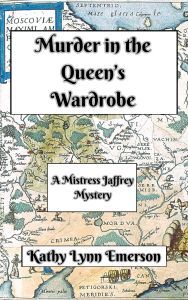
An invitation to readers of this blog: Do you have news relating to Maine, Crime, or Writing? We’d love to hear from you. Just comment below to share.
And a reminder: If your library, school, or organization is looking for a speaker, we are often available to talk about the writing process, research, where we get our ideas, and other mysteries of the business, along with the very popular “Making a Mystery” with audience participation, and “Casting Call: How We Staff Our Mysteries.” We also do programs on Zoom. Contact Kate Flora
Horizontal luxury

John Clark is back to writing regularly and enjoying it. I produce between one and two thousand words a day, with the story scrolling through my head like commercial-free TV. I’m still undecided upon the title, but I think Sailing Past The Apocalypse is likely to be the one I use.
Writing a book about what happens after everything goes to hell allows one an immense amount of freedom since we haven’t quite gotten to a real one yet. (My money is on sometime in early September). Will there be mass hysteria? Will people band together, or kill each other off? How will elected leaders address such a situation? My friends, the literary possibilities are endless.
Mine begins with a rolling electromagnetic pulse-EMP, that starts somewhere in Asia and moves around the globe slowly enough so garbled news of what’s happening s broadcast before it does its damage.
For reference purposes, here’s what one is/does:
Electromagnetic pulse
An EMP is a brief burst of electromagnetic energy that can be natural or artificial.EMPs can occur as a magnetic field, electric field, or electromagnetic field.EMPs can be caused by solar flares or nuclear weapons.EMPs can damage or disrupt electronic devices.EMPs are considered low probability, high consequence events.EMPs can be a threat to the United States power grid.The Commission to Assess the Threat to the United States from Electromagnetic Pulse (EMP) Attack assesses the risk of EMP attacks. (Although this bullet point has likely been eliminated by Elon Musk)In my story, our fear(less) leader panics and pushes the nuclear doomsday button, sending more than a thousand missiles skyward. Just as they reach peak orbit, both their guidance and propulsion systems are fried by the EMP, leaving them floating high in the atmosphere until gravity pulls them down in random fashion. Some detonate, others create huge craters, fracturing bedrock, changing the landscape markedly, or if they detonate/fall at sea, create huge tidal waves.
As for what happens to humanity, I am not ready to let that cat out of the bag, but trust me, it ain’t pretty. There’s also a very strange phenomenon that occurs as people vanish (either dying, or migrating) Weather factors into the story in multiple ways, as does the scary question of what happens to nuclear reactors when an EMP wipes out the mechanisms that control the reaction.
Of course stories need characters. This has four. Seeker is a twenty-two year old guy who functions at the high end of the autism spectrum. Aurora is seventeen, and had to watch her religious fanatic parents suffer a horrible fate. Cygnet is ten, and like Aurora had to witness something horrible happen to her parents, but in markedly different ways, Mom mutated into a giant venomous spider and proceeded to drain Dad dry. The final character is Feather, a telepathic boa constrictor who bonds with Cygnet.
Their adventure begins when Seeker, living well underground in a cavern created by one of the falling missiles, accidentally throws the only remaining book he has in the fire, but is unable to rescue it. He can’t imagine existing without books, so he makes a trip above ground to find new ones. It is this initial small quest that sets in motion a most perilous and interesting journey.
One thing that has made writing this book so smooth is my new way of plotting. I have the luxury of deciding when, or whether to get out of bed. Likewise when to put down the book I’m enjoying and turn out the light. During those twilight periods between sleep and full awakening, I imagine the next portion of the story. Almost invariably, I have the script flowing in my head as soon as I sit down to write more.
One last thought, garnished with a new fancy term. For anyone writing, or wanting to write, literary consumption celibacy is an effort in futility. In other words read whatever the hell you want, whenever you want and it shouldn’t affect your writing one bit.

March 5, 2025
You Heard it Here First – Winter’s On The Run
I’m writing this on the fifth of March, absolutely convinced spring is in the offing.

Looks just wet. Isn’t.
Call me a fool for believing. But after this winter of All The Ice We Could Not See—months of involuntarily shoe skating along sidewalks that appeared to be just wet—today’s long-awaited warm up has me in a whirl.
Did you feel it today? The gentle breeze against your face? It was thirty-seven degrees at 6:40 a.m., and the air was soft, nothing like the sharp-edged wind that’s been the norm for the past couple of months.
You could smell it too, if you took a good, deep breath. My nose perceived damp, earthy and alive, or at least starting to come alive. Not mud yet (oh how I love the scent of mud in March) but not the olfactory monotony of December, January and February.
In Portland, at least, if you listened carefully, a trickle of water was audible beneath the grubby snowbanks.

Enough already.
Tonight’s rain likely will turn those tiny rivulets into rivers rushing along the gutters, evidence of the seasonal transition that’s ugly on the surface, but on a deeper level, so very beautiful.
Soon the early morning birdsong will start building toward its annual crescendo and winter will be gone, baby, gone.
But signs of spring aren’t just in nature. Last weekend the Maine high school basketball championship games were on Maine Public TV, giving the entire state the opportunity to root for teams from towns where they do not know a blessed soul to win the gold ball.

The coveted gold ball (credit: Bangor Daily News)
I truly love this experience and wish the entire tournament still was televised, but that turned out to be another of those don’t-know-what-you’ve-got-till-it’s gone things.
Speaking of high school basketball, if you’ve never read One on One by Tabitha King, I recommend it. You don’t need to be a basketball fan to appreciate the story of a rural school where both the girls and boys’ teams are vying for the state championship, because it’s really a novel about social class and character, learning the difference between winning and losing, and more than anything else, the need to be loved.
Speaking of books, a couple of books by favorite Maine crime writers are on my nightstand right now. One is MCW’s own Jule Selbo’s 7 Days, the fourth in her terrific Dee Rommel series. She wrote about it on this blog in mid-February (the link is here: https://mainecrimewriters.com/2025/02/12/using-all-contacts-for-inspiration/ ) but she didn’t toot her own horn enough. Dee is a believable, funny, brilliant, imperfect, compelling character, and I cannot wait to spend more time with her. Find 7 Days. Buy it. You won’t be sorry.
I’m also keen to read Tess Gerritsen’s The Summer Guests, the second in a new series about several retired spies living in the same Midcoast town. They dissect local crimes during their Martini Club meetings and cannot stop themselves from using their many skills to assist the local police, who do not want (and think they do not need ) any help. Tess has prodigious talent for pacing, character development and devising complex plots. Like all of her books, I expect The Summer Guests to be a master class in how to write a hell of a good mystery.
If my optimism is misplaced and we still have a bit of winter to go, I’ve now given you some wonderful reading suggestions to get you through. And if I’m right, happy spring!
Brenda Buchanan sets her novels in and around Portland. Her three-book Joe Gale series features a contemporary newspaper reporter with old-school style who covers the courts and crime beat at the fictional Portland Daily Chronicle. Brenda’s short story, “Means, Motive, and Opportunity,” was in the anthology Bloodroot: Best New England Crime Stories 2021 and received an honorable mention in Best American Mystery and Suspense 2022. Her story Assumptions Can Get You Killed appears in Wolfsbane: Best New England Crime Stories 2023.
March 4, 2025
Believing in Your Right to Write
 Kate Flora: As many of you know, I spent ten years in the unpublished writers’ corner before I sold my first book, eight before I got an agent and two more before that book saw the light. It was hard ten years, a decade that many aspiring authors find so discouraging they give up. It’s difficult to stay on track, to keep writing and rewriting, when all the system offers in return in rejection.
Kate Flora: As many of you know, I spent ten years in the unpublished writers’ corner before I sold my first book, eight before I got an agent and two more before that book saw the light. It was hard ten years, a decade that many aspiring authors find so discouraging they give up. It’s difficult to stay on track, to keep writing and rewriting, when all the system offers in return in rejection.
It’s also hard to call yourself a writer even if you’ve answered the call to write. If you admit that you’re writing, the first question often asked is: Are you published? Have I read anything you’ve written? It’s uncomfortable to answer that you’re not yet published. I used to give my students a writing prompt involving being at a party and being asked if they are published, and when the answer was no, the questioner walked away.
Drawing on my own experience, I used to ask my students questions to help them understand themselves as writers, and to give them insight into their habits with regard to their writing.
Did they give themselves a dedicated time to write?
Did they have a place to write where they could be undisturbed, a place that supported their desire to write, or did they write at the kitchen table surrounded by family or household demands?

Why write when you can hang out with friends?
When did they do their assignments, right away to afford time for rewriting? Were they willing to give writing the time it deserved or did they tend to blow it off if something else was offered? Deal with that stubborn character or paragraph or yield to the temptation to go out for a beer?
I used to give them a sign that read: Not Now, I’m Writing. I would tell them that only they would know whether the sign needed to go outside of their writing space to keep people away or inside to remind them that they needed to stay there and write.
It’s a sad fact that as writers, we have to be our own cheerleaders. We have to be the ones who believe in the importance of our writing, in our passion for storytelling. Often, we have to defend that against the demands of our jobs, our families, and our other interests.
 I tell aspiring writers that waiting for the fluttery little muse to land on their shoulders and inspire them to write doesn’t usually work. I use the dreaded word “discipline” as often as I use the word “inspiration.” Because if you don’t make the choice to have a dedicated time to write, even on the days when the writing is gravel, you won’t be there when the muse arrives, when the characters take off and begin talking to you, when your story comes so fast you can barely type the words, and when the process is so exciting it leaves you breathless.
I tell aspiring writers that waiting for the fluttery little muse to land on their shoulders and inspire them to write doesn’t usually work. I use the dreaded word “discipline” as often as I use the word “inspiration.” Because if you don’t make the choice to have a dedicated time to write, even on the days when the writing is gravel, you won’t be there when the muse arrives, when the characters take off and begin talking to you, when your story comes so fast you can barely type the words, and when the process is so exciting it leaves you breathless.
I will talk about the difference between writing and getting published. You have the right to write because it matters to you, even if getting published is hard. The first relationship is between you and your story. When it’s about honoring your passion.
 It’s a challenge to acquire the habit of rewriting, or shaping that story so that it is the best it can be. But that’s your job, if you want to be a writer, because, cliché though it may be, writing is both inspiration and perspiration.
It’s a challenge to acquire the habit of rewriting, or shaping that story so that it is the best it can be. But that’s your job, if you want to be a writer, because, cliché though it may be, writing is both inspiration and perspiration.
And even when you have a work that is a polished as you can make it, no one is ever going to knock on the door and demand to see your work. Which is why even if you’ve opened yourself to inspiration, applied discipline, and embraced rewrite, you’re going to need the hide of an alligator to deal with the world of publishing.
But developing the hide of an alligator? That’s for another day.
Lea Wait's Blog
- Lea Wait's profile
- 508 followers



